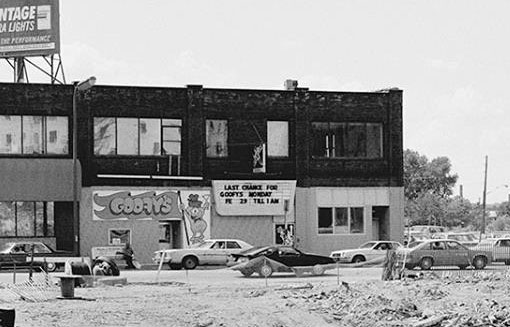Herb’s
Minneapolis
324 MARQUETTE
The three story building at 324 Marquette was a rooming house with a saloon on the first floor in the ‘teens before Prohibition. Notable in the wantads in 1914 and 1915 were the words “White only” and “No Negroes may apply.”
During Prohibition, it appeared that the City of Minneapolis didn’t quite know what to do about drinking and gambling, and evidently gave up on trying to control the gambling in the City. 324 Marquette became McCurran’s, with characters like “Kid” Taylor and “Jake” Stearns running roulette, faro, blackjack, and poker concessions. (April 10, 1922). But then raids resumed, and by the end the building was probably empty because it was hosting church rummage sales.
But then Prohibition came to an end, and it became something called the Met. Cafe, abbreviated because it was only advertised in the wantads. In January 1934 it was up for sale and we learn that it seated 52 people.
PERSIAN BAR
The place was the Persian Bar from April 7, 1934, to 1946. From the ad below, it appears that the Persian Bar was an offshoot of the Persian Club (not the Persian Cat Club, which was another thing entirely), located at 1554 Nicollet Ave. between 1932 and 1934. Like most Prohibition-era establishments, the “Club” got in plenty of hot water before it moved, got itself a license, and did whatever it did down there in the Gateway.
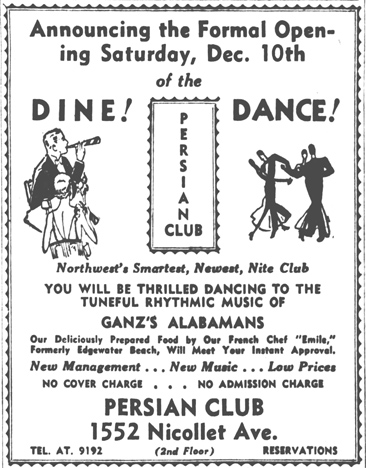
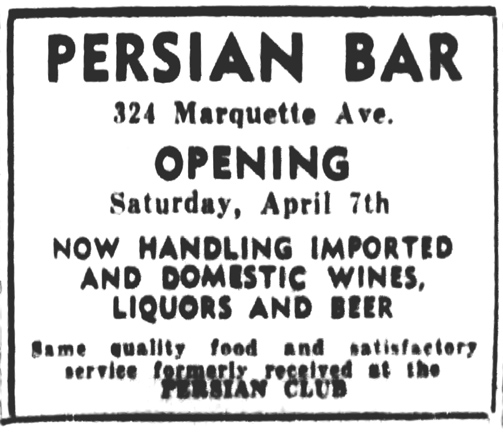
One of the partners at the Persian Bar was Mitch Code, a local mobster who was fortunate to die in 1946 before he received retribution for gambling and drinking away $41,000 while his fellow mobster Tommy Banks was away. (Minneapolis Tribune, June 19, 1959).
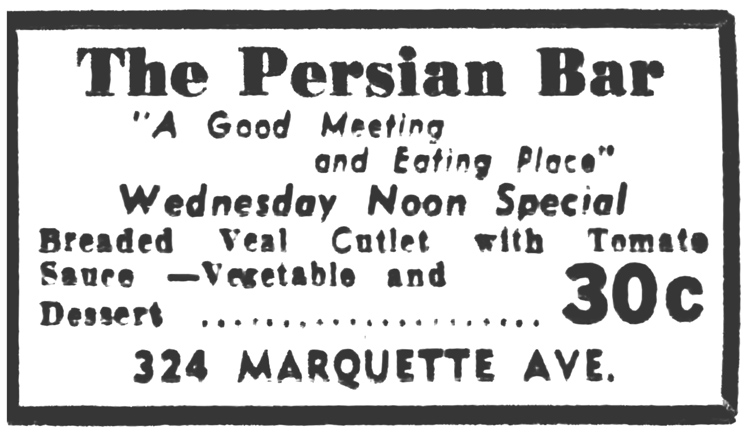
HERB’S #1
Herb’s opened at 324 Marquette Ave. in Minneapolis in 1946. It was owned by Herb Klein, a Big Band singer from the east coast and a brother-in-law of Henry Sabes, who owned the Key Club (Minneapolis Tribune, May 8, 1961). The first thing found in the Minneapolis paper is a blurb about a fight at Herb’s in November 1946 that put a man in General Hospital!
Stebbins described it as “Another night club in Minneapolis which became the principal rallying point for modern jazz musicians in the late 1950s.”
Skeets Reiman played Hammond organ and piano here in 1954.
Stebbins noted that “it was almost ten years before anything of significance for jazz was to be found. Herb Pilhofer, a native German who had arrived in Minneapolis around 1954, led a trio here, off and on, from 1955 to 1961, when the place was torn down…”
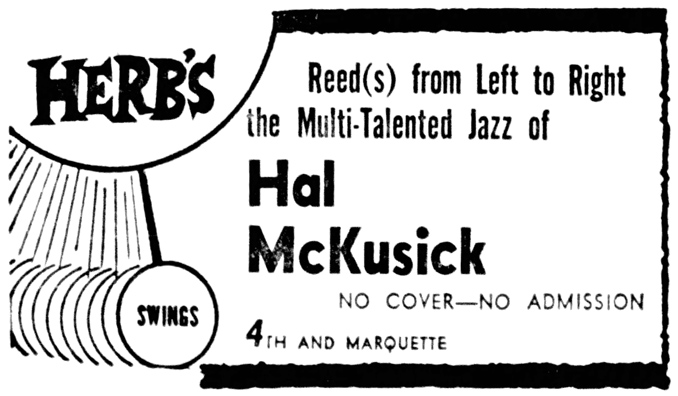
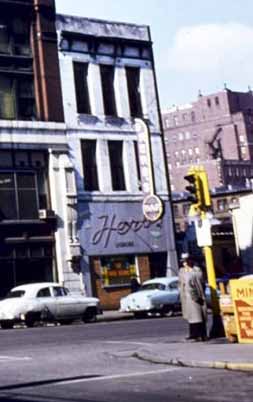
Herb’s preserved a nice balance of local and out of town talent. Twin Cities jazz musicians crowded around to hear Barney Kessel, the Three Sounds, Red Garland’s Trio, Herbie Mann, and others. Often Pilhofer’s trio served as the house band on these occasions.
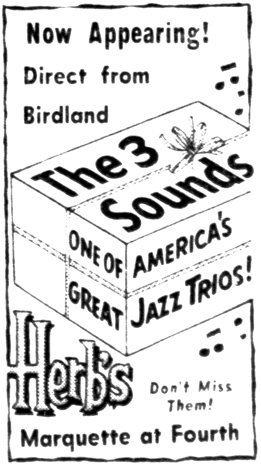
The building was torn down for the Gateway Clearance project. The auction was June 5, 1961. The Sheraton Ritz Hotel was built in 1963, but was demolished in 1990 – the site is now a parking lot.
HERB’S #2: 654 SECOND AVE. NO.
After a stint as the “Host” of the Key Club starting in September 1961, Klein opened a second iteration of Herb’s at 654 Second Ave. No. at Glenwood Ave. in late 1963. His application for a liquor license had been been “bounced around” by Aldermen on the City Council for several weeks until a split decision was reached to approve it on July 12, 1963. (Minneapolis Tribune, July 13, 1963)
Will Jones described the new Herb’s as twice as big as the old place and four times as fancy.
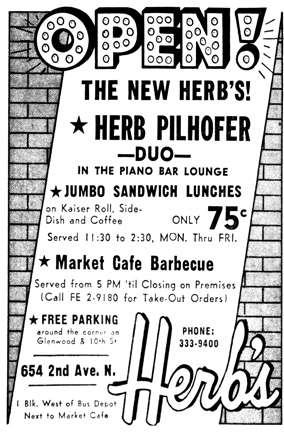
In November 1963 the entertainment was the Herb Pilhofer Duo, with Ted Hughart on bass.
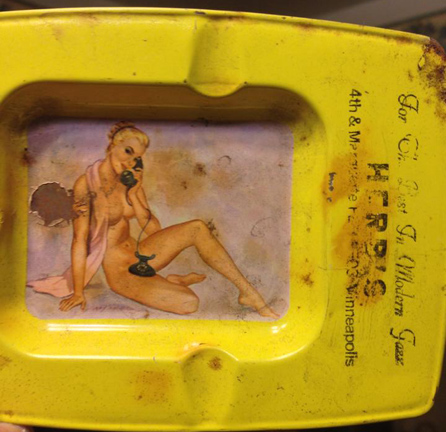
In 1964 the club featured Jim Marentic’s Quartet, a modern jazz band.
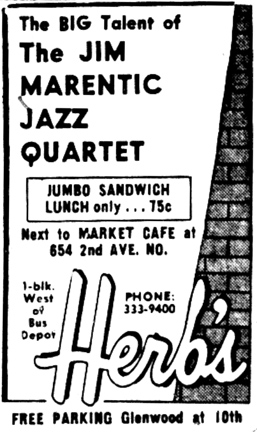
On January 11, 1965, a fire caused $50,000 damage to the club. It was thought to be set by burglars who used acetylene torches to burn through the safe.
From January 1967 to the end of July 1969, the house band was the rock band Gary Neilson and the Nite-Caps.
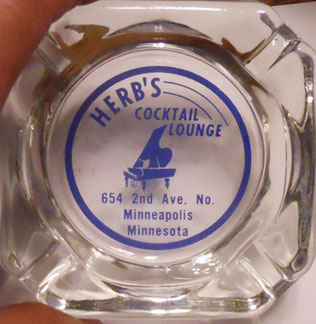
Herb Klein died in 1988.
SWEET GEORGIA BROWN’S
On August 1, 1969, Herb’s became Sweet Georgia Brown’s.
The Frank Edwards Trio was the house combo until a big name policy was instituted in August 1970.
On December 10, 1970, Will Jones reported that Sweet Georgia Brown’s had been closed for about a month, but had reopened under a new name: Big Dee’s.
JETAWAY LOUNGE
March 1971, Will Jones reported that the place had become the New Jetaway, after a popular Miami club. Dick Campbell was the former manager of the Peacock, and became the manager of Sweet Georgia Brown’s in 1970. At that time he enlarged the club for dancing, but in 1972 he discontinued having live bands on week days, as it didn’t pay. He said that all the clubs downtown were “switching over to tapes.” (Minneapolis Tribune, November 27, 1972)
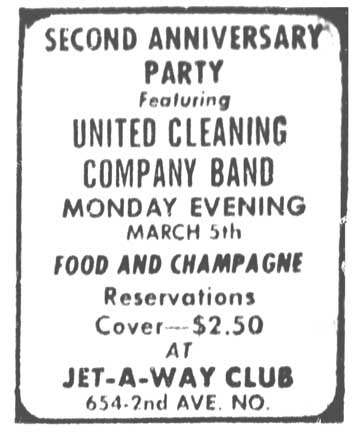
GOOFY’S
In 1974 the place became Goofy’s.
Goofy’s was owned by Moe Emard and Joe Houle. Houle also owned Joe Houle’s Peanut Bar on 26th and Nicollet.
In 1974 it was described as
attracting a large young-and-old crowd after dark with a nutty policy of juke-box dancing and pool-table Foosball and pinball action. Especially popular is a back-of-the-room alcove with bean-bag seating that is separated from the dance floor by a curtain of clear plastic dangles.
A kind of “hang-down hang-out” read one news item.
Folks remember the time clock on the wall – whoever put in the most time at Goofy’s got a free pizza on Friday.
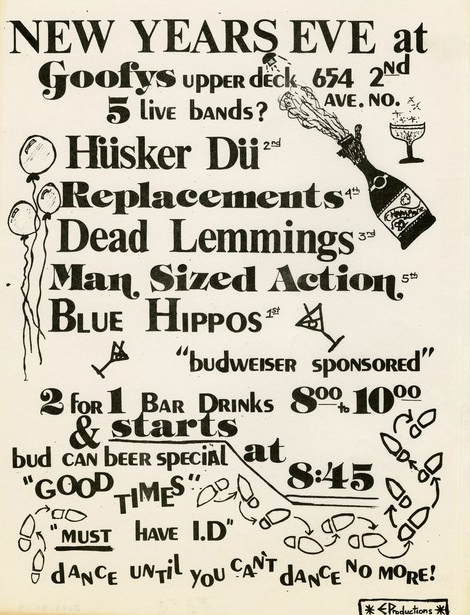
The last mention of the address in the Minneapolis paper was January 15, 1988, when Goofy’s advertised for dancers.
Goofy’s was demolished to make way for the Target Center – its last day was February 29, 1988.
